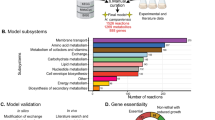Abstract
Methanosarcina barkeri strains (227, MS, and UBS) were tested for their ability to utilize pyruvate for growth and methanogenesis. All three strains grown on methanol required 4–5 weeks of adaptation for growth on pyruvate, whereas they required only 2–3 weeks of adaptation for growth on acetate. The adapted cells had a lag of 3–4 days for growth on acetate and 5–10 days for growth on pyruvate. Equimolar amounts of methane were produced from acetate, whereas 0.6–0.7 mol of methane was produced per mol of pyruvate. The optimal concentration of pyruvate for growth and methanogenesis for all three strains was 100 mM, and doubling times were in the range of 135–170 h.
Similar content being viewed by others
Literature Cited
Asceti DJ, Ferry JG (1988) Purification and characterization of acetate kinase from acetate-grownMethanosarcina thermophila. Evidence for regulation of synthesis. J Biol Chem 263:15444–15448
Balch WE, Wolfe RS (1976) New approach to the cultivation of methanogenic bacteria: 2-mercaptoethane sulfonic acid (HS CoM)-dependent growth ofMethanobacterium ruminantium in a pressurized atmosphere. Appl Environ Microbiol 32:781–791
Blaylock BA (1968) Cobamide-dependent methanol-cyanocob(I)alamin methyltransferase ofMethanosarcina barkeri. Arch Biochem Biophys 124:314–324
Bryant MP, Boone DR (1987) Emended description of strain MST (DSM 800T), the type strain ofMethanosarcina barkeri. Int J Syst Bacteriol 37:169–170
Daniels L, Belay N, Rajagopal BS (1986) Assimilatory reduction of sulfate and sulfite by methanogenic bacteria. Appl Environ Microbiol 51:703–709
Ferry JG (1992) Methane from acetate. J Bacteriol 174:5489–5495
Fuchs G, Stupperich E (1982) Autotrophic CO2 fixation pathway inMethanobacterium thermoautotrophicum. Zentralbl Bakteriol Mikrobiol Hyg 1Abt Orig C3:227–282
Gottschalk G (1986) Bacterial metabolism, 2nd ed, New York, Heidelberg, Berlin: Springer-Verlag
Jetten MSM, Stams AJM, Zehnder AJB (1992) Methanogenesis from acetate: a comparison of the acetate metabolism inMethanothrix soehngenii andMethanosarcina spp. FEMS Microbiol Rev 88:181–198
Kenealy WR, Zeikus JG (1982) One-carbon metabolism in methanogens: evidence for synthesis of a two-carbon cellular intermediate and unification of catabolism and anabolism inMethanosarcina barkeri. J Bacteriol 151:932–941
Krzycki JA, Wolkin RH, Zeikus JG (1982) Comparison of unitrophic and mixotrophic substrate metabolism by an acetateadapted strain ofMethanosarcina barkeri. J Bacteriol 149:247–254
Lundie LL Jr, Ferry JG (1989) Activation of acetate byMethanosarcina thermophila. J Biol Chem 264:18392–18396
Mah RA, Smith MR, Baresi L (1978) Studies on acetatefermenting strain ofMethanosarcina. Appl Environ Microbiol 35:1174–1184
Markwell MAK, Haas SM, Beiber LL, Tolbert NE (1978) A modification of the Lowry procedure to simplify protein determination in membrane and lipoprotein samples. Anal Biochem 87:206–210
Oremland RS (1988) Biogeochemistry of methanogenic bacteria. In: Zehnder AJB (ed) Biology of anaerobic microorganisms. New York: John Wiley & Sons, pp 641–705
Sparling R, Daniels L (1987) The specificity of growth inhibition of methanogenic bacteria by bromoethanesulfonate. Can J Microbiol 33:1132–1136
Terlesky KC, Nelson MJK, Ferry JG (1986) Isolation of an enzyme complex with carbon monoxide dehydrogenase activity containing corrinoid and nickel from acetate-grownMethanosarcina thermophila. J Bacteriol 168:1053–1058
Van Andel JG, Breure AM (1984) Anaerobic waste treatment. Trends Biotechnol 2:16–20
Vogels GD, Keltjens JT, Van Der Drift C (1988) Biochemistry of methane production. In: Zehnder AJB (ed) Biology of anaerobic microorganisms. New York: John Wiley & Sons, pp 707–770
Weimer PJ, Zeikus JG (1978a) One-carbon metabolism in methanogenic bacteria: cellular characterization and growth ofMethanosarcina barkeri. Arch Microbiol 119:49–57
Weimer PJ, Zeikus JG (1978b) Acetate metabolism inMethanosarcina barkeri. Arch Microbiol 119:175–182
Wolin EA, Wolin MJ, Wolfe RS (1963) Formation of methane by bacterial extracts. J Biol Chem 238:2882–2886
Yang ST, Okos MR (1987) Kinetic study and mathematical modeling of methanogenesis of acetate using pure cultures of methanogens. Biotechnol Bioeng 30:661–667
Zeikus JG, Winfrey MR (1976) Temperature limitation of methanogenesis in aquatic sediments. Appl Environ Microbiol 31:99–107
Author information
Authors and Affiliations
Rights and permissions
About this article
Cite this article
Rajagopal, B.S., LeGall, J. Pyruvate as a substrate for growth and methanogenesis forMethanosarcina barkeri . Current Microbiology 28, 307–311 (1994). https://doi.org/10.1007/BF01573211
Issue Date:
DOI: https://doi.org/10.1007/BF01573211




